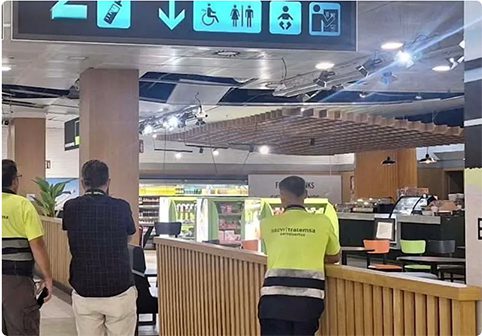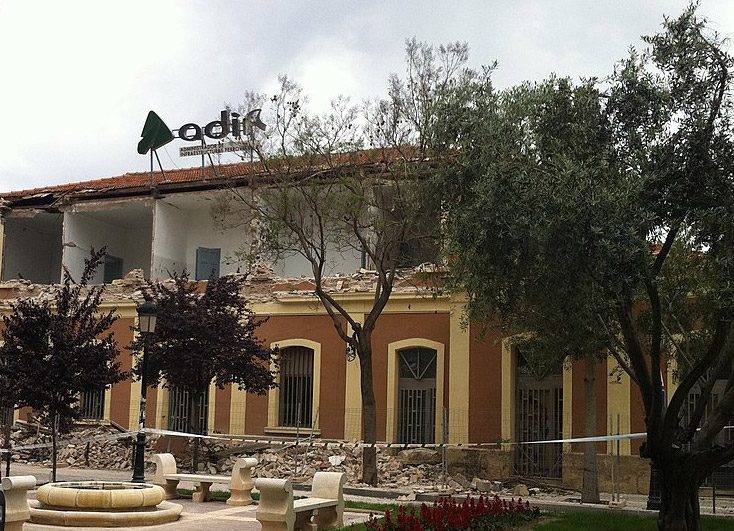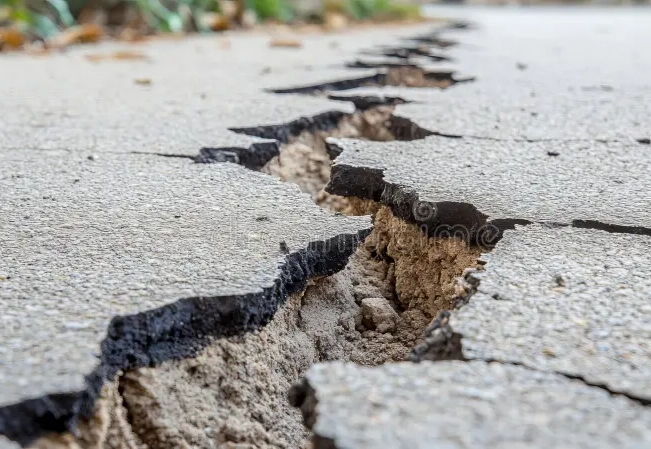JUST WHEN old guys in village bar would be enjoying their first ‘sol y sombra’, at 7:13 a.m. on Sunday, July 14, there was an earthquajke in Spain. Yes, the earth moved – 70km from Almería and 224km from Málaga. A 5.4 magnitude earthquake, shallow in the Alborán Sea, rippled across southern Spain, rattling windows, shaking beds, and collapsing part of a false ceiling at Almería airport. It also damaging the celing of a Toyota dealership in Huércal de Almería, ironically called Alborán Motor. It was felt mainly in the Axarquia (Torre del Mar and Velez-Malaga).
Soon, the media headlines were equally shaky and unstable about the “major” earthquake in Spain! It was the most powerful quake in the region in over two decades. It even triggered a tsunami alert on people’s phones!
Although none of this equates to the plot of ‘The Day After Tomorrow’, it was enough to send delighted tabloid journos scrambling for adjectives such as “dust cloud”, “collapses,” “shakes”, and “panics.” As with our recent Air Disasters article, the excitement was palpable.
Meanwhile, in the westerly side of the Alpujarra of Granada, in towns such as Órgiva, many residents slept peacefully through the quake, their dreams undisturbed by the movement of tectonic plates. These are, specifically, the Iberian plate and the African plate, which are converging. These two plates are responsible for seismic activity in the region, particularly in the Alborán Sea which lies between Spain and the North of Africa. Minor earthquakes in Spain are commonplace.

Panic stations (again)
To the seasoned Iberian quake-spotter, this shaker wasn’t quite as exciting as its press depiction. You can monitor recent seismic events on various websites dedicated to this topic. The earthquake originated 3 km beneath the Alborán Sea, near the Perla de Andalucía: Cabo de Gata. That shallow depth gave it reach, as it was felt in Málaga, Granada, Almería, and even Alicante. However, it didn’t have much destructive power.
There were no injuries. The “cloud of dust” appeared momentarily at the airport café. This, of course, did not stop the tabloids from maximising the opportunity for horror headlines (as with “air disasters”) about this great, big earthquake in Spain.
Airport roof collapses as Spain hit by powerful earthquake – ‘The Independent’
Southeast Spain rocked by severe earthquake as tourist hotspots suffer severe floods – LBC
Spain earthquake collapses ceiling at holiday airport as tremors felt in hundreds of towns following 5.4-mag shaker – ‘The Sun’
And of course, your humble correspondent’s former paper, ‘The Olive Press’, gave us: “Earthquake shakes homes from Malaga to Alicante and briefly triggers tsunami alert in the Mediterranean.”
Meanwhile in Órgiva…
Reports suggest that the ‘de facto’ capital of La Alpujarra – Órgiva kind of missed the event. One man even comment that his bed rocked for different reasons. Too much information?
“Was that an earthquake?”
“Nah, probably Hilde next door fell over doing her morning Yoga moves.”
This lack of “teeth” is not unusual. Earthquakes, unless particularly sharp or awkwardly angled, can frequently be missed in mountainous regions — especially if you’re lying on a comfortable mattress, having 40 winks (or other activities).
Spain’s shaky past
OK, so we are veering towards humour with this article, but some earthquakes are no laughing matter. There is always the possibility that damage and danger will occur at some point. Here are some historical earthquakes explained:
Lorca, 2011 – A 5.1 quake killed nine people and injured hundreds. It was unusually shallow and struck directly beneath the town.

Santa Fe, Granada, 2021 – A “swarm” of quakes (over 1,000!), that have since been studied widely by seismologists, frightened the residents, caused cracks in some buildings, and drove many people to sleep outside or visit relatives in other areas.
Murcia, 18 May 1911 – A magnitude 6.0 earthquake occurred near Lorca, Murcia, leaving 30 dead and hundreds injured. Lorca was hit hard, with many buildings destroyed or cracked. It foreshadowed the 2011 disaster in the same city, where building weaknesses were again revealed.
Lisbon, 1755 – Not technically Spain (as it’s in Portugal!), but the catastrophic 8.5+ quake destroyed much of Lisbon and was felt in Cádiz and Seville.
How far can you feel an earthquake in Spain?
Those of us who dwell on the mountains South of Granada might reasonably ask: “If a quake is at sea level, how far up a mountain would you feel it?” This depends on several factors such as the depth of the quake (shallow equals widespread) and the geology (i.e. mountains tend to muffle shockwaves).
At 5.4 magnitude, many coastal and inland towns noticed the recent earthquake. However, higher up in La Alpujarra, les so. You are likely to notice it less if there is a pneumatic drill operating beside your house or the washing machine is on spin cycle.
There is a lot to be said for mountain-dwelling in the event of natural diasters including earthquake, flood, or disease. But not wildfire.
What did British residents actually notice?
The reporter asked on a local forum if the earthquake shook people up, or was a non-event for residents of the area.
While many people noticed nothing, and remained peacefully asleep, others definitely felt tremors – but nothing living up to the media hype.
Órgiva resident, Sherene, says: “Another terrible danger to add to scorching temperatures, wildfires, protesting locals, and bits falling off planes… it’s a wonder anyone is left alive.”
Coulton said: “My phone has an earthquake alarm and it went off just as it happened.”
Deborah says: “I never feel them. It was a bigger one than usual but nothing to worry about and it was out at sea. There was no danger of a tsunami but it might have made a notable swell, which I think the advisory was for. These ‘news’ papers are grabbing at straws to distract from what’s going on in the world.”
Another local resident, Brett, said: “I did feel it! But, I am currently 20 minutes away from Mojacar. It was quite noticeable.”
People based nearer to Almería widely reported feeling the tremor. One British holidaymaker, in Lobras, near Cadiar (towards the eastern side of La Alpujarra), said she felt her bed shake. Her friend, Alison – staying in Almeria – felt the whole building shake. A British man being treated in Motril hospital “felt the bed shake for 10 seconds.”
However, while concerning some residents, this is a far cry from the tales of dust and destruction being reported in the media!

What about Santorini, Greece, this year?
Just weeks ago, Greek authorities ran volcanic evacuation drills on the island of Santorini after a spate of minor tremors and rising gas emissions from the submerged, local caldera scared many residents and visitors. Anecdotally, a friend of the reporter’s mother was frightened on Cyprus – another Greek island – by tremors and a ‘calima’ that made everything red with dust. Volcanologist, Stavros Papazachos, warned that the Aegean region is “increasingly unstable,” and that historical intervals between eruptions are shortening.
No, this doesn’t mean a pan-Mediterranean catastrophe is pending. But it pays to remain aware and monitor reliable information sources about tectonic tendencies, as well as travel advice pages.
What to do in an earthquake (other than panic!)
- Seek cover under a stable object – Under a table is better than out in the open.
- Stay away from windows – Not because of spying neighbours, but flying glass.
- Avoid lifts – Earthquakes and elevators are not compatible.
- If outside, stay outside – Not under balconies or crumbling statues of saints.
- Don’t rush to the beach – If there is a tsunami, you’re heading in the wrong direction.
Final thoughts from the Fault Line
There’s something fascinating about earthquakes (not that we want to see damage). The reporter has been standing in Órgiva when one apparently happened, and didn’t notice a thing! Or sleeping at 1,700m. Or out of the area/the country. First-hand experience is lacking here.
Although residents aren’t over-reacting, the same thing cannot be said of the press, that just WANTS to report a disaster.
